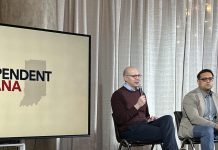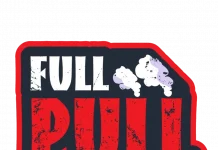INTERVIEW WITH INDIANA STATE SENATOR JIM TOMES!
by: Dan Barton, Publisher of The New-Harmony GazetteÂ
These are excerpts of an interview with Indiana State Senator Jim Tomes conducted by the New Harmony Gazette Publisher, Dan Barton:
DAN BARTON – I would like to thank you for helping Lora Arneberg and the Harmony Way Bridge Committee in getting the Bridge Authority Bill passed by the Indiana Legislature. This can work to get funding for reopening the bridge. It has been a long time coming.
JIM TOMES – Yes. That’s true.
DB – Other Legislators have tried and failed in the past. We appreciate all that you’ve done to help get that accomplished. Lora Arneberg has said that you’ve been a great help.
JIM TOMES – I was just honored to be a part of it.
DB – You have said that one of the most important things you thought about in terms of the multitude of problems that suddenly cropped up in New Harmony was the possible damage to our Wabash River shoreline. There hasn’t been a United States Geodesic Survey Study done in several years to determine what damage if any, there is underneath the rip-rap on the northern riverbank that was laid down by the Army Corps of Engineers in about 2002. The concern by some is that the river may be doing considerable damage underneath this revetment and that it needs to be assessed. If the rip-rap were to collapse where the river strikes that area, it could come into New Harmony.
JIM TOMES – Yes it could.
DB – About a year ago, three of our citizens here in New Harmony went to Indianapolis and met with several different government agencies about the possible erosion of our Wabash River shoreline. Particularly the northwest riverbank. The outcome was that the U.S.G.S would initially partly fund the study but that New Harmony would have to fund (A/O December 2017) some $15,000 or 80% of the project. Council president Blaylock wanted to get a better deal and asked Councilman Flanders, who had been a member of the three-person panel, to go back and get a lower price. (Since the Gazette meeting with Jim Tomes, Councilman David Flanders has come back to the Town Council with some adjusted figures by USGS for both a one-time study and for two surveys. For a one time survey of the riverbank, New Harmony’s cost would be $7,300. A two-time study, both 2018 and 2020, would cost New Harmony $15,600.)
So once again, like the Harmony Way Bridge and the New Harmony School, it’s the citizens of New Harmony who are left to fend for themselves. This is a very serious issue. We don’t know today whether the river has seriously undercut the shoreline or not. But we need to find out.
I would like to hear some of your ideas on this.
JIM TOMES – Well, on the issue of the bridge, you know, since I first got elected I’ve been trying to get the bridge re-opened. I drove across that bridge many, many times when I was driving trucks for a living. I crossed it when I was driving for Yellow Freight and I know how critical that bridge is. I know we’ve got the Interstate and the bridge in Mt. Vernon and that’s nice, but the Harmony Way Bridge is a crucial roadway for getting from Carmi to over here. I knew how important it was and what a strain it has put on this community by closing it. And then the school closed and that was another big hit.
But my concern was not only the bridge and the school but also this Wabash River. I remember in my first year after being elected, a conservation group brought me to look at some property that they owned. We were out in one of the cornfields and I noticed that the corn stubble was right at the edge of the riverbank. I was thinking, “ Now I know that farmer didn’t plant that corn that closes to the edge.†While we were talking a big chunk of ground just broke off and fell into the river. I mean a BIG chunk. When it splashed it got our attention. A few moments later another big chunk broke lose. So we walked back from the river’s edge. That river is fast flowing even when it is at a low level.
I will never forget that visit and see that landfall off; soil, ground, gone forever. I remember when Margie and I were working at Harmony State Park after I retired, part-time, around 2008. We went to bed one night, got up the next morning, and the river had taken up a couple of thousand acres. Just like that! Overnight!
Congressman Larry Bucshon, Tom Straw and the Corps of Engineers took us just north of town to see the rip-rap. We were watching that river. Tom Straw had a lot of information and contour maps showing how that river has changed course over time. It was obvious that this should be the main concern.
The Wabash River and the floods we’ve been having lately – I remember several years ago that there was water in the streets here and people were pumping water out of their basements. They’d never done that before. Around 2014, I had a meeting up here with the Corps of Engineers. That’s when they came up here talking about the floodplain.
DB – There have been calls for a shoreline study to determine whether the Wabash is undercutting.
JIM TOMES – Someone here in New Harmony needs to come up with a workable approach to this. I mean a real idea like the one they came up with about the bridge. The idea Lora Arneberg presented was fabulous. She did a fabulous job. That took a lot of work. It wasn’t done overnight. She was persistent in that. When that came up it was an example of people who got together with a legitimate suggestion. By far more than anything else presented.
Some folks had ideas that were too grandiose. No one had a really good idea of how they would implement their ideas. What’s good about the Bridge Authority idea is that the government is not totally involved in it. They are not involved in the operation of the Authority. This will be the responsibility of the people who control the Authority itself. When individuals are doing it and the government’s not involved then it works more efficiently. I know money is always an issue but I like the way this was done. I think it’s great!
It took a lot of drive to get this Authority idea off the ground. A lot of fire, and staying with it. And being successful against all odds.
DB – To get back to the river shoreline matter – and the study that some of our people think is needed, do you know of a way that someone in the State Capitol can help out on this U.S.G.S Study? A grant or money to cover the gap in funds for this? This is really a State funding issue. The Town of New Harmony could use help on these infrastructure problems. If you know anyone up there who can be instrumental in this and you can put them in touch with me, I will then put them in touch with the Councilman who has been pushing for the study.
( At this point Senator Tomes pointed out to me that I should try to get in touch with Lt. Governor Crouch, either at a local meeting or luncheon that she schedules here in New Harmony or SW Indiana or through her office. I decided to communicate with the L.G.s Press Secretary and to find out about a meeting or what the L.G.s schedule for SW Indiana is like. So far that information has not been forthcoming. The other remark that Senator Tomes made to me was, that to succeed in our endeavor, we must be persistent, persistence is the key. I will keep trying.)
NEW HARMONY TOWN COUNCIL SHORELINE REPORT! by: Dan Barton, Publisher, The New-Harmony Gazette.
** Most recently, at the June 19th, New Harmony Town Council meeting, Roger Wade, and Alvin Blaylock both indicated that they had taken a boat ride up the Wabash with an Elastec, Inc. boat and crew using equipment supplied by Elastec to scan the river bottom and shoreline. It showed a hole in the river bottom only 26 feet deep, and not what had been previously reported as 60 feet deep, according to Wade. They said the rip-rap shoreline had a gradual incline with no indication of damage. Councilman Wade said that they found no anomalies on the scan that would indicate any problems with the state of the rip-rap or the NW Shoreline. He said that they will be taking another look in the Fall when Elastec returns to the area. Neither Blaylock nor Wade are known to be trained Hydrologists or Sonar Technicians. It looks like the Town has postponed or unofficially decided against Councilman Flanders idea for a more extensive examination of the NW Shore by U.S.G.S.
The advantage of a U.S.G.S. study is that U.S.G.S. formalizes the study that they do with a full scale is written report and copies of the river shoreline and river bottom scan.
U.S.G.S. Technicians are also trained for this type of study. They do data/slices that can be compared with previous U.S.G.S. studies to show trends from previous studies taken. Copies of these reports are filed and kept at the Working Men’s Institute in perpetuity, just in case anyone wishes to study them. The Blaylock, Wade study, or what I call the B.W.G.S. study, has no such formal procedure. Untrained observers wouldn’t know whether what they observed shows a trend or the depth of holes, dimensions of cracks and rip-rap shoreline displacement. They would not be the best-trained observers and couldn’t professionally assess the health of the riprap. Since there is no scanned copy or written report from B.W.G.S. we only have their testimony via the New Harmony Town Council meeting minutes of what they say they saw and how safe and secure they think everything is. It would be a good idea if these Councilmen had their study results from Elastec certified by the U.S.G.S. as accurate. They could submit their report for certification, which could later be filed with WMI along with all of the other study reports, for future public access.
As a follow up I called Elastic and spoke to Vice President Jeff Cantrell. He said that Blaylock/Wade did take the boat trip. Cantrell wasn’t on the boat but heard about it. He said that they wanted to eyeball the shoreline and rip-rap but when they saw the Garmin fish finder on board they asked to look at the images that it produced to view the river bottom. Cantrell said the device has GPS and is a fish/river bottom scanner. I asked him if the scan was kept on record or if there was an official report by Elastic. He said no to both questions. He also said
that Elastec was not certifying or interpreting the scan results. He said, “No! That’s not our business. It’s not what we do.†He indicated that the analysis was strictly interpreted by Blaylock and Wade. Cantrell was asked by me if the Fish Finder was as good as what U.S.G.S. uses and he said there was no comparison. He said that U.S.G.S. uses a much more sophisticated Side-Scan sonar that is made just for doing the type of analysis we were talking about, i.e. shelf erosion, contours of the river bottom and the condition of the rip-rap. The last point here is that U.S.G.S. would be looking beyond the rip-rap itself and at the entire shoreline for deterioration and erosion. How does this compare to the Blaylock/Wade analysis? **
FOOTNOTE: Â PART ONE: THE WABASH RIVER SHORELINE & NEW BRIDGE AUTHORITY. Â In PART TWO: next month – Senator Tomes discusses the New Harmony School closing.




